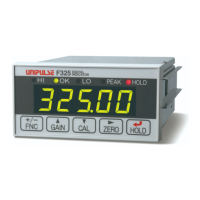29
4 Calibration
29
Calibration
Chapter
4
4-1. Calibration method
"Calibration" is the operation of matching the F325 with a strain gauge type sensor. The following
two kinds of calibration methods are available for the F325.
◇Actual load calibration
In this calibration method, actual load is applied to a strain gauge type sensor, and the value of the
actual load is input using the keys.
Accurate calibration with minimal error can be performed.
◇Equivalent input calibration
In this calibration method, only the rated output value (mV/V) and the rated capacity value (one to
be displayed) of a strain gauge type sensor is input using the keys. This method does not involve
actual load. Calibration can be easily performed even when actual load cannot be applied.
For example, the gain is automatically determined by entering values as follows:
Force: 2.001mV/V-100.0kgf
Pressure: 2.002mV/V-10.00kgf/cm
2
Torque: 2.502mV/V-15.00kgf・m
* Perform either equivalent input calibration or actual load calibration.
A data sheet is included with a strain gauge type sensor when purchased.
The following values are indicated in the data sheet.
Capacity ----- Force (unit: kg, t and so on)
Rated output ----- Voltage (unit: mV/V)
Non-linearity, Hysteresis,
Input resistance, Output resistance,
Zero balance
The two values required in equivalent input calibration are the capacity and rated
output. Input these two values into the F325.
Key points

